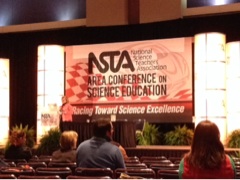It is a pleasure and honor to be speaking to science teachers today, especially in this state that owes so much to science and education. There is also no small part of irony at this conference being held in North Carolina. I wrote about that here, so will say nothing more about it.

Today, I will talk about learning, as opposed to teaching. I want you to understand that one of the aspects of our students’ outside-the-classroom culture that we too often fail to appreciate is that it is fueled by learning. New games, new features in their social networks, and all the new ideas that they share via texting – along with the trash. It is all based on learning. When I was growing up, you learned a game and then you played it. ..and you played it that way for ever. Our students learn a game, and then a new version comes out, and they have to learn new rules. Those rules do not appear under the game-box lid. They have to learn the rules by playing the game.
There are six qualities of that outside-the-classroom learning experience that are worth our understanding, and four of them I will demonstrate today. They are that the ‘native’ learning experience
- Is responsive,
- It provoke conversation
- It inspires personal investment and
- It is guided by safely made mistakes
Here are links to some ancillary materials for this presentation:
- Online Handouts for Cracking the Code of the ‘Native Learning Experience
- The transcript for the session’s backchannel conversation.
 One moment that really tickled me at the conference was when, after a session was over, a petite dark-haired teacher turned turned to me, and a middle-aged man and said, “I'm young. How am I ever going to keep up with all this technology. Such a reversal or rolls, as we think that young folks will have any problem with all this new tech.
One moment that really tickled me at the conference was when, after a session was over, a petite dark-haired teacher turned turned to me, and a middle-aged man and said, “I'm young. How am I ever going to keep up with all this technology. Such a reversal or rolls, as we think that young folks will have any problem with all this new tech.














